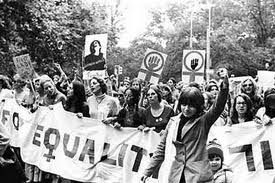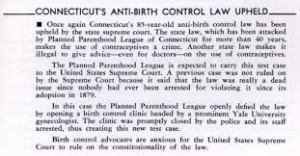The New Anti-feminists: Have They Talked to Their Mothers or Grandmothers?
Today, in support of the Women’s March in Washington, D.C., I am posting a blog I published a little over two years ago. It is more relevant than ever. I also want to call your attention to an Op-Ed piece written by Gloria Steinem that appeared yesterday in the Boston Globe. In it she explains how sexism and racism are intertwined and how equal rights for women and the fight for racial equality under the law came to be joint goals of the pioneers in the Women’s Movement for Equality.
Thanks to the young bloggers I follow, most especially Natacha Guyot and Jennie Saia, my attention has been drawn to a trend among young women, who are posting photos on Tumblr and other social media sites proclaiming, in effect, that they are anti-feminists. The first thought I had after seeing these photos was a question: Have these young women spoken to their mothers, grandmothers, or aunts about what they encountered as women in society or in the workplace when they were younger? I can’t imagine they’ve had those conversations. As a woman who lived through the decades of the push for equality in the workplace and encountered anti-equality attitudes at various points in her career, I feel compelled to address these young women who don’t know what it was like to pursue a career in an unequal and unregulated work environment.
We need to remember across generations that there is as much to learn as there is to teach—Gloria Steinem
I was graduated from high school at the time that Betty Friedan and Gloria Steinem were just speaking up for equal rights for women. It was a time when women in the workplace were expected to support the men, who did the thinking and the “important” work. Women served in clerical roles, typing, filing, and making coffee and cleaning up afterwards. Yes, the world of Mad Men prevailed. You could have shone a light on any profession in the 40s and 50s, and the same ethos would have been apparent. In medicine, with rare exceptions, men were doctors. Equally bright, and sometimes brighter, women were nurses. In the Fortune 500 corporations, men were executives, and women were lucky to be administrative assistants or secretaries, wholly without decision-making duties. In Western society men were still considered the breadwinners and the women who worked were assumed to be marking time until they had children, or they had returned to work after their children were grown in order to earn extra spending money. And it was open season on women in the workplace. Sexual harassment was unfettered and unregulated by law. If you need film reminders of how women were treated in the workplace, just watch Nine to Five or The Apartment.
During my senior year in college (1968 to 1969), I started looking for a position as a teacher. I was lucky to land an interview with the Superintendent of Schools in a town not too far from where I lived. He said he had reviewed my application and letters of recommendation and I appeared to be qualified for the position. He needed to know one thing, however. “Do you have a boyfriend?”
“No,” I stammered.
“Good,” he said. “At least I’ll get two years out of you before you leave to have babies.”
Can the young women, posing as anti-feminists on social media, imagine themselves in a similar situation during a job interview? Of course, the answer is no. Today, women are protected by legislation that was hard won by feminists who marched and organized and worked for equality—equality in pay, career advancement, and educational opportunities—as well as freedom from sexual harassment at work. These achievements didn’t come about overnight. It took years of advocacy to change the laws and to change the thinking that had created second-class citizenship for women.
And the feminists worked for equality in more than just the work environment. They worked to give women control of their bodies and reproductive rights, equal financial rights, and protection from domestic abuse. A review of some of the protective legislation shows the far-reaching efforts of the feminist movement in the United States, as follows:
The Equal Pay Act of 1963. The Equal Pay Act mandates equal payment for equal work with provision made for seniority, a merit system, a system that measures earnings by quantity or quality of production, or a differential based on any other factor other than sex. See the website of the Equal Employment Opportunity Commission:
Title VII of the Civil Rights Act of 1964. Title VII protects applicants and employees against discrimination. It prohibits employers from making employment-related decisions, such as hiring, firing, or promoting, where the decision is motivated by a person’s race, color, religion, sex or national origin Title VII is also the federal statute which makes sexual harassment unlawful.
Griswold v. Connecticut Supreme Court Ruling of 1965. In a landmark case the Supreme Court of the United States ruled that the Constitution protected the right to marital privacy. The case involved a Connecticut statute that prohibited people from using a drug, medical article or instrument to prevent conception.
Yes, if you are following, that means that birth control was prohibited in Connecticut until the Supreme Court ruled. I am hoping this glimpse into what feminists helped to overturn will open a few eyes among the young women anti-feminists, as well as their significant others.
Other equally important legal victories that the feminist movement helped to win included the following:
- The 1967 Executive Order giving full affirmative action rights to women
- The 1968 EEOC (Equal Employment Opportunity Commission) decision that sex-segregated help wanted ads were illegal
- Title X of the Public Health Service Act in 1970, creating the only American federal program devoted to the provision of family planning services
- Title IX in 1972 and the Women’s Educational Equity Act in 1974 that mandated educational equality
- The1973 Supreme Court’s Roe v. Wade decision that laws prohibiting abortion are unconstitutional
- The 1974 Equal Credit Opportunity Act, prohibiting discrimination in consumer credit practices on the basis of sex, race, marital status, religion, national origin, age, or receipt of public assistance
- The 1975 law requiring the U.S. military academies to admit women
- The 1978 Pregnancy Discrimination Act, banning employment discrimination against pregnant women, prohibiting firing, denying a job to, or failing to promote a woman because she is pregnant
The feminists fought for equal status for women in society in general, within the educational system, the workplace, the home, and within the financial world. In the United States today a woman can qualify for a mortgage, buy a car, apply for credit, have equal access to the educational system, exercise control over her reproductive life, and pursue a career, as a result of the feminist movement. These are not rights to be taken for granted. They were neither my rights when I entered the workplace nor were they the rights of my mother or grandmother. Sadly, many women in too many parts of the world still do not have these basic rights.
As Jennie Saia pointed out in her blog on the anti-feminist postings, feminists fought for equality. They didn’t seek to diminish the rights of men. They wanted to be considered equal under the law and to have the rights guaranteed under the U.S. constitution. As a wife and the mother of a son, I would never support legislation that disenfranchised men or promoted women to the disadvantage of men. Like other women and men before me, I support equality and freedom for all.
If we are going to become a society in which there is equal opportunity for all, we need to be vigilant to preserve the rights already won as we move toward winning rights for all disenfranchised groups. As Emma Watson said in her address at the United Nations, feminism is just a word. Let us look beyond the word, men and women together.
If you’ve been following the Feminist Friday discussions organized and promoted by GeneO’, you know that the latest round of posts related to feminism ended on Friday. If you missed this last round, check it out on his blog; then follow the links to the bloggers who posted. If you have something to say about feminism, say it. Send me a link to your blog when you do.
Feminist Friday: What Are Strong Female Characters?
As part of the Feminist Friday postings organized by GeneO, I am posting Hannah Givens’ contribution. Let’s keep the discussion going. Please visit her blog and leave a comment.
You may have noticed I’ve been blogging about female characters all week! Well, there’s a reason: I want to discuss the concept of “strong female characters” today. That phrase gets thrown around a lot, but people have widely varying ideas of a) what a strong female character is, and b) what a strong female character is supposed to accomplish in the real world. So, let’s compare notes.
In its most casual usage, the phrase seems to mean either a female warrior or a female character who gets a lot of “screentime” in the story. Both of these things can certainly be important. Women are traditionally not portrayed as warriors or physically/emotionally “strong,” and as we talked about two weeks ago, the Bechdel Test illustrates that women are often only present as token supporting characters in a male character’s story. (There’s nothing wrong with telling stories…
View original post 642 more words
Feminist Friday: “It is not the word that is important but the idea and the ambition behind it”
Here is another contribution to the Feminist Friday discussions. This one focuses on Emma Watson’s plea for gender equality at the United Nations this week. Join the discussion!
Feminist Friday: How Valuable is the Bechdel Test?

I have been following the Feminist Friday discussions organized by GeneO,’ and today I am posting the first discussion from the new round of Feminist Friday offerings. I thank Natacha Guyot for introducing me to the series. Please go to Victim to Charm to join the discussion.
Think about the last movie you saw. Were there two or more female characters? Did they talk to each other about something besides men?
The Bechdel test, created by Alison Bechdel, examines female roles in movies by asking three questions:
- Are there two or more women in the film?
- Do they talk to each other?
- Is their conversation about something other than a man?
 From Alison Bechdel’s comic strip “Dykes to Watch Out For” (1985).
From Alison Bechdel’s comic strip “Dykes to Watch Out For” (1985).
The test seems simple—women talk to each other about things besides men all the time in real life—yet a surprisingly high number of movies fail to represent this basic activity.
 The test is so basic because it’s a standard that should be easy to pass. The fact that so many movies fail to achieve one, two, or all three of the test’s clauses highlights the rampant misogyny of the film industry. If a movie can’t…
The test is so basic because it’s a standard that should be easy to pass. The fact that so many movies fail to achieve one, two, or all three of the test’s clauses highlights the rampant misogyny of the film industry. If a movie can’t…
View original post 436 more words

![images[5] (2)](https://jsherwinblog.files.wordpress.com/2014/09/images5-2.jpg?w=225&h=300)







